Wyoming and Climate Change: CO2 Should Be Celebrated, Not Captured
EXECUTIVE SUMMARY
This report examines the actual and projected effects of the climate on the State of Wyoming in response to proposals to reduce emissions of carbon dioxide (CO2) through the use of “carbon capture” in order to avert purportedly catastrophic atmospheric warming.
This research concludes that Wyoming – like the planet – is benefiting from warming that began more than 300 years ago. Efforts to reduce CO2 emissions are unnecessary and exorbitantly expensive and would make no measurable difference in temperature.
Carbon Dioxide
Claims that carbon dioxide is a pollutant posing an “existential threat” are contradicted by scientific data. Today’s levels of CO2, while representing a recent increase, are significantly lower than they have been during nearly all of Earth’s history.
Pre-Industrial Revolution CO2 levels were approximately 280 parts per million (ppm) and began accelerating in the mid-20th century during the post-World War II economic boom. Current levels are about 420 ppm, a 50% increase during the last 200 years. Though elevated compared to the recent past, modern concentrations of CO2 are one-sixth of the average over the last 600 million years. Viewed in this geologic context, we are at near-historically low levels of CO2.
Temperature
Data for Wyoming contradict the 4th National Climate Assessment (NCA4) assertion that “the frequency and intensity of extreme high temperature events are virtually certain to increase.”
Our data analysis shows that high daily temperatures peaked during the Dust Bowl years of the 1930s and have been in a 90-year decline. This is confirmed by reviewing the percentage of days that were reported to be hotter than 100°F (37.8°C) by Wyoming temperature stations. There is no discernible increase, and the largest numbers occurred in the first half of the 20th century when CO2 levels were 70% of recent measurements.
There has been, however, a beneficial increase in the minimum nighttime temperatures, which has led to a lengthening of the Wyoming growing season. Since the late 1800s, these nighttime temperatures have increased about 2°F (1.1°C).
In summary, the slight increase of about 1.2°F (0.7°C) in the average temperature in the last 120 years is being driven by reductions in extreme cold rather than increases in extreme heat.
Wyoming annual average maximum temperature vs. atmospheric carbon dioxide
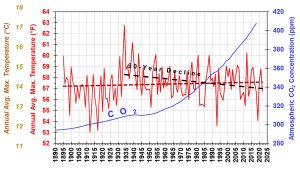
Temperature source: NOAA National Centers for Environmental Information (2023c)
CO2 source: European Environment Agency (2019)
Precipitation
Although drought is projected by the most recent National Climate Assessment (NCA4) to worsen because of climate change, the historical data refute this claim. The most notable characteristic of Wyoming precipitation is that the amount varies greatly year-to-year but exhibits no overall trend of increase or decrease. Precipitation in Wyoming appears to be controlled primarily by short-term weather-driven events and not by any CO2-linked climate change.
Similarly, NCA4 predicts declining snowpack, but real-world observations show that only two of eight ski resorts in the state experienced a declining trend in snowfall over the last decade, while five showed increasing snowfalls.
Wyoming annual precipitaon (inches), 1895–2023
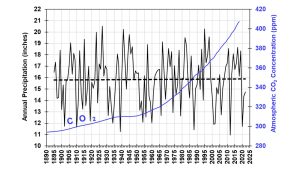
Precipitation source: NOAA National Centers for Environmental Information (2023a)
CO2 source: European Environment Agency (2019)
Severe Weather
NCA4 claims an increasing incidence of severe weather is a product of climate change, but scientific data indicate no such trend. According to the World Health Organization’s Centre for Research on the Epidemiology of Disasters, deaths from natural disasters have plunged more than 90% from a yearly average of 54,000 in the 1920s to 4,500 in the last decade. The incidence of tornadoes, which are Wyoming’s primary dangerous weather hazard, varies year-to-year but shows no discernible trend of increase.
Global deaths from natural disasters (average per decade)
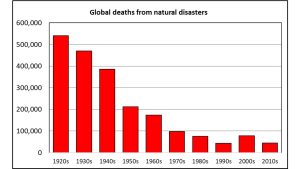
Source: EM-DAT (2022)
Agriculture
Contrary to claims of agricultural declines, global food production is greatly outpacing population growth. This boost in agriculture is attributable to modest warming, increasing carbon dioxide (CO2 fertilization effect) and the use of fossil fuel-derived nitrogen fertilizers. Because of a naturally warmer climate and the CO2 produced by the use of fossil fuels, the world currently sustains tenfold the number of people (8.04 billion) than at the beginning of the Industrial Revolution (791 million).
Furthermore, modestly rising temperatures are benefiting Wyoming agriculture by extending growing seasons. On a broader scale, the length of growing seasons in the contiguous United States has increased by more than two weeks since the beginning of the 20th century.
Global food production index, population and land use for agriculture
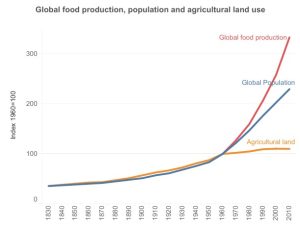
Source: OECD (2023)
Greening
The most significant positive consequence of rising concentrations of atmospheric carbon dioxide is that of greatly increased plant growth. Global leaf area increased by a stunning 5.4 million km2 from 2000 to 2017. This area is equivalent to the area of the Amazon rainforest. Notably, the Northern Great Plains is one of seven areas globally experiencing the greatest increase in plant growth.
A greening planet
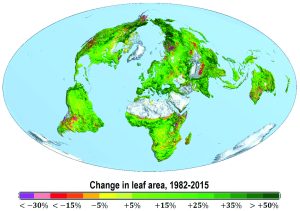
(Modified from Zhu 2016, permission R Myneni)
Emission Reduction Costs and Effects
A review of recent CO2 emission data from the U.S. Energy Information Administration (EIA 2016) reveals that Wyoming emissions were 1.2% of the U.S. total. Assuming elimination of Wyoming’s CO2 emissions in 2010, the amount of warming averted would be only 0.0009°F (0.0005°C) by 2050 and 0.0012°F (0.0022°C) by 2100. This temperature difference is far less than humans experience every few seconds in a “constant” environment – far below our ability to even measure and scarcely different from zero.
Amount of warming averted by eliminaon of CO2 emissions

(MAGICC – Model for the Assessment of Greenhouse Gas–Induced Climate Change)
Models for Future Climate Predictions
Plans to spend enormous sums of money in a rush to “net zero” are based on mathematically complicated computer models that predict a significant rise in future temperatures. However, the models regularly fail to replicate real-world observations and have been found to overestimate warming effects by two to five times.
This scientific analysis shows that Wyoming’s ecosystems are thriving and prospering. Furthermore, the state’s deposits of fossil fuels represent not only a valuable energy source but a reserve of carbon whose release into the atmosphere as carbon dioxide promises to benefit plant and animal life for centuries.
BACKGROUND
The CO2 Coalition was established in 2015 as a non-partisan educational foundation operating under Section 501(c)(3) of the IRS code for the purpose of educating thought leaders, policy makers, and the public about the important contribution made by carbon dioxide (CO2) to our lives and economy. The CO2 Coalition seeks to engage in an informed and dispassionate discussion of climate change, humans’ role in the climate system, the limitations of climate models, and the consequences of mandated reductions in CO2 emissions.
This report is the fourth in a series of state and regional studies by the CO2 Coalition on the effects of the changing climate on various parts of the United States of America. Previous regional and state reports include:
- Pennsylvania’s Regional Greenhouse Gas Initiative Relies on Faulty Data: Why RGGI is a “Solution in Search of a Problem” (July 2021).
- Virginia and Climate Change: Separating Fact from Fiction (June 2022).
- The American Midwest and Climate Change: Life in America’s Breadbasket is Good and Getting Better (June 2023).
The current report is based principally on the work of the following:
- Frits Byron Soepyan – CO2 Coalition Research and Science Associate, Ph.D. Chemical Engineering
- Gregory Wrightstone – CO2 Coalition Executive Director, MS Geology
- William Happer – CO2 Coalition Chair, Ph.D. Physics
These and other contributors to this evaluation represent the fields of climatology, meteorology, physics, geology, agronomy, engineering and more.
INTRODUCTION
Wyoming has vast resources of coal, oil and natural gas. With 40% of the nation’s coal resources, the state has been the United States’ top producer since 1986, primarily from the Powder River Basin located in the northeastern part of the state. It is also a national leader in the production of oil and natural gas, ranking in the top 10 in production of both products. According to the U.S. Energy Information Administration (EIA 2023), the Cowboy State produces almost 12 times more energy than it consumes, making it the second largest net energy supplier among the states after Texas.
Even though the Wyoming economy is heavily dependent on the mining and extraction of fossil fuels, its governor, Mark Gordon, has adopted a strong “decarbonization” policy. At a speech to the Harvard Kennedy School’s Institute of Politics in late 2023 (Frumkin and Healey 2023), he stated:
It is clear that we have a warming climate. It is clear that carbon dioxide is a major contributor to that challenge. There is an urgency to addressing this issue.
The Governor accepts that there will be CO2-driven climate change disasters. To reduce the state’s production of carbon dioxide, he advocates that Wyoming become “carbon negative” using carbon capture technology to remove more CO2 from the atmosphere than is emitted by the people and industries of the state.
Opposition to the governor’s carbon capture plan was swift, with the Wyoming GOP passing a no confidence vote:
Governor Gordon’s current path accepting climate change, and his goals of decarbonizing the West, is counterproductive to the best interests of Wyoming.
That was followed by a letter from 30 legislators and the Secretary of State demanding that the Governor convene a debate that would include experts provided by the CO2 Coalition to determine the cause and effect of climate change and the merits of his “carbon negative” policy. After first accepting the debate challenge, he later reneged. In the letter demanding a debate, Sen. Cheri Steinmetz stated:
We believe that all Wyomingites will most benefit from a real, in-depth discussion of these issues. It is time for a fair debate at a neutral location, with a neutral moderator of your choosing
The CO2 Coalition believes that public policy on such matters should be driven by scientific review and analysis, not political agendas. To provide that scientific analysis, this report will review data that we would have provided to the governor had a debate occurred. We encourage those in positions to make policy decisions to dispassionately review the data included here to determine the answers to the following questions:
- Is Wyoming experiencing a climate crisis?
- Are extreme weather events like droughts, floods, crop failure and heat waves increasing in Wyoming?
- How much warming would be averted if Wyoming emitted no carbon dioxide?
- Are increasing levels of carbon dioxide beneficial or harmful?
The answers to these questions and much more will be addressed here using peer-reviewed papers and data from governmental and statutory agencies. The information included will provide Governor Gordon and the Wyoming legislature facts to support their decision-making about energy and climate policy.
You can download the complete Wyoming and Climate Change report here.
